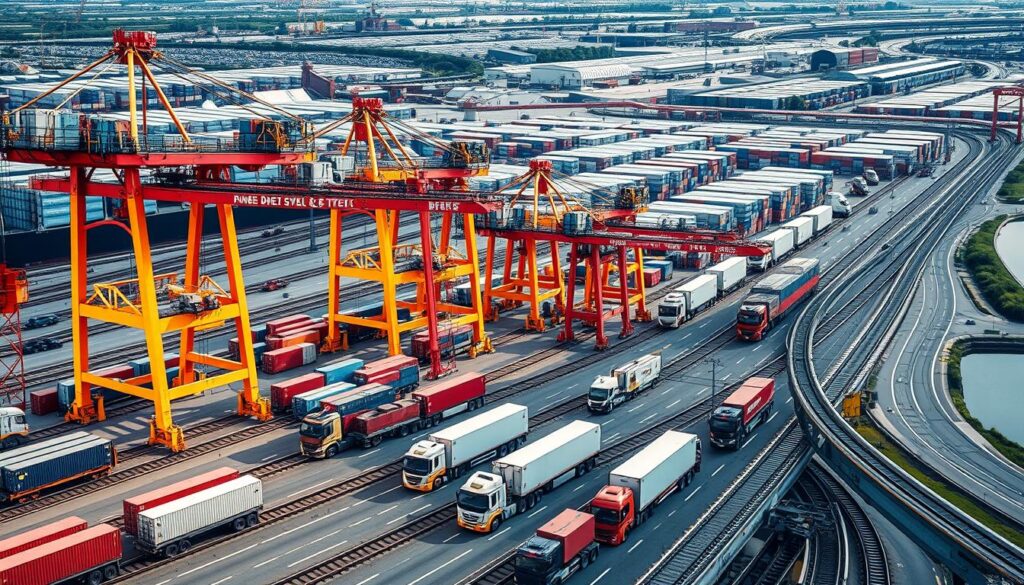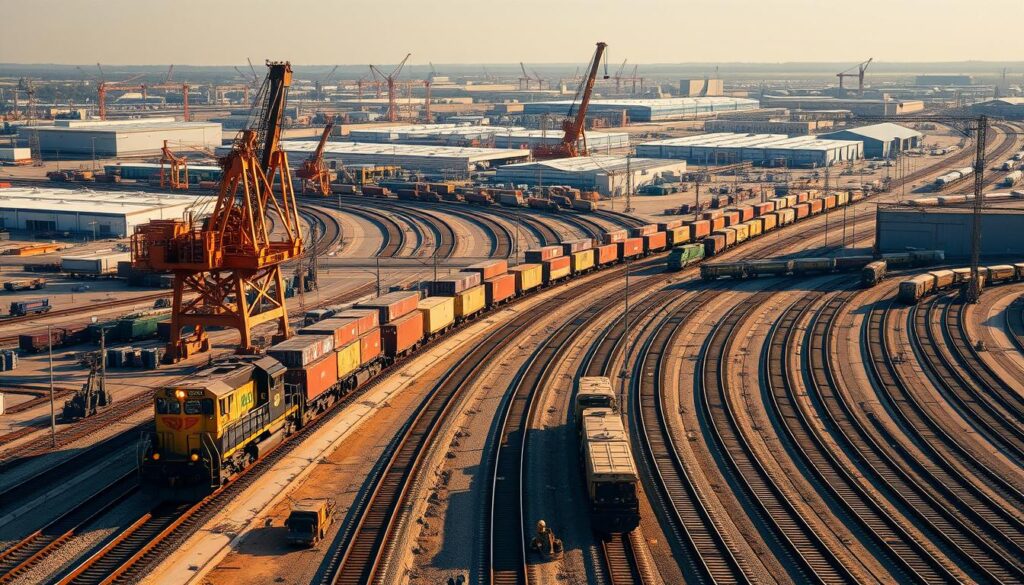Are you using rail freight transport to its fullest in your logistics?
Rail has been key in global supply chains for nearly two centuries. It offers a mix of efficiency and capacity. Today, it’s still a big plus for moving lots of goods efficiently.
When you want to make your transport logistics better, think about the perks of rail freight transport. It can really help your business.
Using smart strategies in your logistics can make your business more productive. This helps you stay ahead in a fast-changing market.
Key Takeaways
- Understanding the historical significance of rail in global supply chains
- Recognizing the efficiency and capacity benefits of rail freight transport
- Optimizing transport logistics for improved productivity
- Leveraging rail cargo services for competitive advantage
- Implementing strategies to boost logistics efficiency
The Evolution of Rail Freight Transport in America
The rail freight transport in America has changed a lot over time. It has kept up with the country’s economy and infrastructure. Now, it’s a key part of the US’s transportation system.
Current State of Rail Freight in the United States
The U.S. freight rail network is huge, safe, and cost-effective. It spans almost 140,000 route miles. This network helps move goods all over the country, supporting many industries.
Major Rail Networks and Their Coverage
The US rail network has many operators. Each one serves different areas, covering the whole country.
Class I Railroads and Their Service Areas
Class I railroads are the biggest, handling most of the freight. They connect big cities and industrial areas across the country.
Regional and Short Line Operators
Regional and short line operators fill gaps not covered by Class I railroads. They are crucial for getting goods to their final destinations.
| Railroad Type | Service Area | Primary Commodities |
|---|---|---|
| Class I | National/International | Coal, Intermodal, Chemicals |
| Regional | Specific Regions | Agricultural Products, Minerals |
| Short Line | Local Areas | Forest Products, Metals |
Together, Class I, regional, and short line operators make a strong rail transport network. This network is vital for the US economy. As demand for freight shipping by rail grows, the industry will evolve. This will be driven by new technology and the need for green transport solutions.
Why Rail Freight Transport Outperforms Other Shipping Methods
Rail transport is a top choice for shipping, offering savings and being kind to the environment. It’s a smart pick for your logistics needs.
Environmental Benefits and Carbon Footprint Reduction
Rail freight is green, moving one ton of freight 470 miles on just one gallon of diesel. This makes it better for the planet than other ways to ship.
Cost Efficiency for Long-Distance Shipping
For long trips, rail freight saves money. It’s a budget-friendly option for businesses wanting to cut shipping costs without losing reliability.
Reliability Factors in American Rail Systems
Rail freight is reliable, thanks to its weather resistance and avoiding traffic jams.
Weather Resistance Compared to Trucking
Rail transport is less affected by weather than trucks, keeping delivery times steady.
Congestion Avoidance Benefits
With its own rail lines, freight shipping by rail dodges highway traffic, making it more dependable.
| Shipping Method | Fuel Efficiency (ton-miles/gallon) | Carbon Emissions |
|---|---|---|
| Rail Freight | 470 | Low |
| Trucking | 117 | High |
Choosing rail freight means you get efficiency, cost savings, and reliability. It’s the best choice for your shipping needs.
Assessing Your Company’s Rail Freight Needs
It’s important to check if rail freight fits your logistics plan. You need to look at several key points. These points help make rail transport efficient and cost-effective.
Evaluating Cargo Types Suitable for Rail Transport
Rail is great for moving big items and containers over long distances. Check if your cargo fits well with rail transport. Think about the weight, size, and if it needs special care. For example, coal, grain, and chemicals are often moved by rail because they’re heavy and in bulk.
Volume Considerations and Economies of Scale
How much you ship matters a lot for rail freight costs. Big shipments get better prices because of economies of scale. Look at your shipping amounts to see if rail can save you money.
Distance Analysis: When Rail Makes Financial Sense
Distance is key too. For long trips, rail is often cheaper than other ways to ship. Find out when using rail is best for your business by analyzing distances.
While rail freight is cost-effective for long distances, air transport remains unmatched in speed for urgent shipments. Discover the benefits in our blog Unlock the Wonders of Air Transport.
Break-Even Distance Calculations
Figuring out the break-even distance helps know when rail is cheaper. This means comparing costs of different ways to ship over different distances.
Transit Time vs. Cost Trade-offs
Think about the balance between how fast you need your goods and how much you’re willing to pay. Rail might save money but isn’t always the quickest. Decide what’s more important for your business.
Developing Your Rail Logistics Strategy
To stay ahead, you must craft a rail logistics plan that boosts your supply chain. It’s about knowing what your company needs and matching it with the rail network’s strengths.
Setting Measurable Objectives and KPIs
Start by setting clear goals that match your business aims. Use Key Performance Indicators (KPIs) like transit times and cost per ton-mile. These metrics will show if your strategy is working.
Mapping Optimal Routes Across the US Rail Network
Finding the best routes is vital for rail success. Think about transloading facilities, key spots for goods to switch between transport modes. Optimizing routes cuts down on time and expenses.
Scheduling Considerations for Maximum Efficiency
Good scheduling is crucial for rail’s full benefits. Plan lead times well and know how seasonal changes affect rail capacity.
Lead Time Planning
Planning lead times is key to on-time delivery. You need to grasp the rail network’s workings and possible slowdowns.
Seasonal Variations in Rail Capacity
Seasonal demand shifts can change rail capacity. Anticipating these changes helps keep your supply chain running smoothly.
Creating a solid rail logistics strategy boosts your company’s market edge. It’s about more than just knowing the rail network. It’s about using it to meet your business goals.
Choosing the Right Rail Cargo Services for Your Business
Your business needs the right rail cargo services for efficient and cost-effective freight shipping. There are many options, so it’s important to know the differences. This helps you make a smart choice.
Unit Trains vs. Carload Service vs. Intermodal
Rail cargo services include unit trains, carload service, and intermodal transport. Unit trains carry one type of cargo, great for big volumes. Carload service ships goods in single railcars, good for smaller or varied cargo. Intermodal transport uses rail and truck, offering flexibility.
Specialized Equipment Options for Different Commodities
Different goods need special rail equipment. For example, covered hoppers are for grain, and tank cars are for liquids. Knowing the equipment options is key for safe and efficient transport.
Service Provider Evaluation Criteria
When picking a rail cargo service provider, consider several things. Important factors include:
- Reliability and on-time performance
- Pricing structure and cost transparency
- Range of services and equipment options
- Customer service and support
Reliability Metrics to Consider
Reliability is key in rail cargo services. Look at on-time arrival rates and transit times. A reliable provider offers consistent service and few delays.
Pricing Structure Comparison
It’s vital to compare pricing among providers. Seek clear pricing with no hidden fees. Think about the total shipping cost, including extra services.
Implementing Effective Intermodal Transportation Solutions
Looking to boost your logistics? Intermodal transportation could be the answer. It combines rail, truck, and port connections for a smooth supply chain.
Rail-Truck Integration Strategies
Linking rail and truck services is key for a smooth flow. You need to coordinate schedules, manage cargo transfers, and use both modes well. This cuts down transit times and costs.
Key considerations for rail-truck integration include:
- Coordinating rail and truck schedules to minimize delays
- Selecting optimal transfer points for cargo
- Ensuring compatibility between rail and truck equipment
Port Connections for International Shipments
For global shipments, port connections are vital. You must understand port operations, handle customs clearance, and ensure cargo transfers are smooth.
Managing Transfer Points to Minimize Delays
Transfer points are crucial in intermodal transport. Good management here can cut down delays and keep cargo moving smoothly.
Drayage Operations Optimization
Drayage operations move cargo between ports, rail yards, and facilities. Making these operations more efficient can save costs and boost performance.
Terminal Selection Criteria
Picking the right terminal is essential for efficient transport. Look at location, equipment availability, and service quality.
Here’s a comparison of key factors to consider when selecting a terminal:
| Factor | Importance | Example |
|---|---|---|
| Location | High | Proximity to major highways or ports |
| Equipment Availability | High | Availability of cranes, forklifts, etc. |
| Service Quality | Medium | Reliability, customer service |

Optimizing Your Rail Transport Network for Maximum Efficiency
To get the most out of freight forwarding by rail, you need to optimize your rail transport network. This means focusing on network design, service models, and capacity planning.
Network Design Principles for US Rail Operations
Good network design is key for efficient rail operations. It’s about planning routes, terminals, and equipment to cut down on delays and costs. Important principles include:
- Optimizing route configurations for reduced transit times
- Strategically locating terminals for efficient cargo handling
- Implementing flexible network designs to accommodate varying demand
Hub-and-Spoke vs. Direct Service Models
Deciding between hub-and-spoke and direct service models depends on your rail shipping needs. Hub-and-spoke models send cargo to central hubs before it goes to its final destination. Direct service models send cargo straight from the start to the end.
| Criteria | Hub-and-Spoke | Direct Service |
|---|---|---|
| Transit Time | Generally longer due to consolidation and transfer | Faster, as cargo is transported directly |
| Cost | Can be more cost-effective for high-volume shipments | More expensive due to dedicated service |
Capacity Planning and Utilization Improvement
Capacity planning is vital for making your rail network more efficient. This includes:
Equipment Positioning Strategies
Putting equipment where it’s needed most cuts down on idle time and boosts productivity. It’s about studying demand patterns and adjusting equipment placement based on that.
Empty Miles Reduction Techniques
Lowering empty miles saves money and helps the environment. Ways to do this include optimizing routes to cut down on empty trips and using backhaul strategies to increase loaded miles.
By using these strategies, you can greatly improve your rail transport network’s efficiency. This leads to cost savings and happier customers.
Mastering Freight Forwarding by Rail
Effective freight forwarding by rail requires understanding complex documentation and regulations. Mastering these elements helps manage rail logistics efficiently.
Essential Documentation for Domestic Rail Shipments
Domestic rail shipments need the right documents. A bill of lading acts as a contract between the shipper and carrier. A freight invoice details the shipment costs.
Be aware of any specific regulations or certifications for your cargo. Hazardous materials need special handling and documentation.
Cross-Border Requirements for US-Canada/Mexico Trade
Cross-border shipments require extra documentation and follow international regulations. For US-Canada/Mexico trade, prepare for customs clearance with a commercial invoice, a certificate of origin, and other required documents.
Knowing the Harmonized System (HS) codes for your goods is crucial. These codes affect duties and taxes on your shipment.
Insurance and Liability Management
Managing risk is key in freight forwarding by rail. Consider various cargo insurance options to protect your goods against loss or damage.
Cargo Insurance Options
Choose from all-risk insurance and named-peril insurance based on your cargo and risk tolerance.
Damage Prevention Best Practices
Preventing damage is vital. Use proper packaging, secure cargo, and monitor shipments in transit.
These strategies help minimize damage risk and ensure your goods arrive safely.
Leveraging Technology to Enhance Rail Shipping Solutions
Advanced technologies are changing rail shipping for the better. They make it more efficient and reliable. Technology is key to improving your rail logistics.
Real-Time Tracking and Visibility Platforms
Real-time tracking is a big deal for rail shipping solutions. It lets you see where your shipments are at any time. This helps you make better choices and keeps customers happy.
Predictive Analytics for Delay Prevention
Predictive analytics help prevent delays. It uses past data and current info to predict issues. This way, you can manage your intermodal transportation better.
Automation Tools for Documentation and Compliance
Automation tools make paperwork easier and keep you in line with rules. They save time and cut down on mistakes.
EDI Implementation for Rail Carriers
Using Electronic Data Interchange (EDI) makes talking to rail carriers smoother. It boosts the efficiency of your rail logistics.
TMS Integration Strategies
Integrating a Transportation Management System (TMS) is crucial. It helps plan and execute your shipping better.

By using these technologies, you can make your rail shipping better. This makes your operations more efficient and competitive.
Overcoming Common Challenges in Rail Freight Transport
When you’re in the rail freight transport world, you’ll face many challenges. These include service disruptions, peak season capacity issues, and last-mile delivery problems.
Strategies for Dealing with Service Disruptions
Service disruptions can really hurt your rail freight plans. Here’s how to tackle them:
- Make backup plans for when things go wrong
- Get systems for tracking and monitoring in real-time
- Keep in close touch with your rail service providers
Managing Peak Season Capacity Constraints
Peak seasons can make it hard to get rail freight space. Here’s what to do:
- Book your space early to avoid last-minute scrambles
- Look into other routes or transport options
- Be flexible with your shipping times
Addressing Last-Mile Delivery Coordination
Last-mile delivery is key for on-time delivery. But, there are challenges:
Urban Delivery Challenges
In cities, traffic and parking can block delivery. Here’s how to fix it:
- Use urban centers for consolidating shipments
- Plan your routes and schedules carefully
Rural Service Solutions
In rural areas, the main problem is lack of infrastructure. Here’s how to solve it:
- Work with local delivery services
- Invest in flexible, adaptable delivery methods
| Challenge | Urban Solution | Rural Solution |
|---|---|---|
| Limited Infrastructure | Urban Consolidation Centers | Partner with Local Services |
| Traffic Congestion | Efficient Routing | Flexible Delivery Schedules |
By knowing these challenges and using smart solutions, you can make your rail freight transport better. This will help you work more efficiently.
Measuring and Continuously Improving Rail Logistics Performance
Improving rail logistics needs a data-driven approach. You must track key performance indicators (KPIs) and use methods that help improve. This is key to optimizing your rail logistics operations.
Essential KPIs for Rail Freight Operations
To see how well your rail logistics work, look at these KPIs:
- On-time delivery rates
- Transit times
- Damage or loss rates
- Customer satisfaction scores
Implementing Continuous Improvement Methodologies
Using Lean and Six Sigma can spot and fix inefficiencies. These methods promote a culture of ongoing improvement in your rail logistics.
Benchmarking Against Industry Standards
Comparing your performance to industry standards shows your strengths and weaknesses. This involves:
Data Collection Methods
Collecting data from your transportation management system and customer feedback.
Performance Review Processes
Regularly checking your performance data to find trends and areas to get better.
Conclusion: Building a Sustainable Rail Freight Strategy
Creating a sustainable rail freight strategy is key for businesses looking to improve their transport logistics. Knowing how rail freight has evolved and its advantages helps you make better choices for your rail cargo services.
When planning your rail freight strategy, think about your company’s needs. Consider what you’re shipping, how much, and over what distance. This helps you find the best and most cost-effective rail transport options.
To build a sustainable strategy, focus on a detailed logistics plan. Include rail freight transport and other logistics elements. This approach can cut costs, speed up deliveries, and make your supply chain more efficient.
By following the advice in this article, you can develop a sustainable rail freight strategy. This will help your business grow and succeed.

